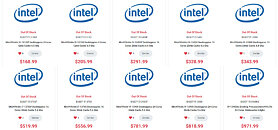- Joined
- Oct 9, 2007
- Messages
- 47,670 (7.43/day)
- Location
- Dublin, Ireland
| System Name | RBMK-1000 |
|---|---|
| Processor | AMD Ryzen 7 5700G |
| Motherboard | Gigabyte B550 AORUS Elite V2 |
| Cooling | DeepCool Gammax L240 V2 |
| Memory | 2x 16GB DDR4-3200 |
| Video Card(s) | Galax RTX 4070 Ti EX |
| Storage | Samsung 990 1TB |
| Display(s) | BenQ 1440p 60 Hz 27-inch |
| Case | Corsair Carbide 100R |
| Audio Device(s) | ASUS SupremeFX S1220A |
| Power Supply | Cooler Master MWE Gold 650W |
| Mouse | ASUS ROG Strix Impact |
| Keyboard | Gamdias Hermes E2 |
| Software | Windows 11 Pro |
Intel's upcoming Core i9-13900KS flagship processor is expected to be an estimated 22% pricier than the i9-13900K, suggests a Canadian retailer with early placeholder listings for chips that won't be in stock for months from now. The i9-13900KS is expected to be the world's first 6 GHz retail desktop processor, with its maximum boost frequency either at or beyond 6.00 GHz, compared to the 5.80 GHz of the i9-13900K. The chip will be built from the topmost tier bins of the "Raptor Lake-S" silicon. As this point we don't know if it comes with a higher Maximum Turbo Power (MTP) value than the 253 W of the i9-13900K.
Intel is designing the Core i9-13900KS to ward off the threat from AMD's Ryzen 7 7800X3D "Zen 4" processor that incorporates 3D Vertical Cache technology for a significant gaming performance uplift. 3DV cache raised gaming performance of "Zen 3" up to the levels of 12th Gen Core "Alder Lake" processors, and the expectation now is that it will similarly raise gaming performance of "Zen 4" to be competitive with that of "Raptor Lake."

View at TechPowerUp Main Site | Source
Intel is designing the Core i9-13900KS to ward off the threat from AMD's Ryzen 7 7800X3D "Zen 4" processor that incorporates 3D Vertical Cache technology for a significant gaming performance uplift. 3DV cache raised gaming performance of "Zen 3" up to the levels of 12th Gen Core "Alder Lake" processors, and the expectation now is that it will similarly raise gaming performance of "Zen 4" to be competitive with that of "Raptor Lake."

View at TechPowerUp Main Site | Source








